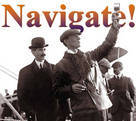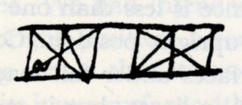|

 Up
Up 
 Summing Up
Summing Up

(You are here.)



  Need
to Need
to
find your
bearings?
Try
these
navigation aids:
If
this is your first
visit, please stop by:
Something
to share?
Please:



|
|
In
Their Own Words
 ilbur
and Orville left Kitty Hawk, North Carolina on October 23, 1900 and
arrived at Dayton, Ohio a few days later. After
settling back into his routine and thinking about his experience in the
Outerbanks for a few weeks, Wilbur sat down and described his
experiences to Octave Chanute: ilbur
and Orville left Kitty Hawk, North Carolina on October 23, 1900 and
arrived at Dayton, Ohio a few days later. After
settling back into his routine and thinking about his experience in the
Outerbanks for a few weeks, Wilbur sat down and described his
experiences to Octave Chanute:
Octave Chanute
Chicago, Illinois
November 16, 1900
In October my brother and myself spent a vacation
of several weeks at Kitty Hawk, North Carolina, experimenting with a
soaring machine. We located on the bar which separates Albemarle Sound
from the ocean. South of Kitty Hawk the bar is absolutely bare of
vegetation and flat as a floor, from sound to ocean, for a distance of
nearly five miles, except a sand hill one hundred and five ft. high
which rises almost in its center. The main slope of the hill is to the
northeast, which is facing the prevailing winds. The slope is one in six
(9° 28'). To the north, northeast, east, and southeast there is nothing
but flat plain and ocean for a thousand miles nearly. It is an ideal
place for gliding experiments except for its inaccessibility. The person
who goes there must take everything he will possibly need, for he cannot
depend on getting any needed article from the outside world in less than
three weeks.
|
|
|
The machine we used was a double-decker with surfaces 17 ft. by 5 ft. A
space eighteen inches wide was cut out of the lower surface, so the net
surface was about one hundred and sixty-five feet, and the weight with
operator was 190 lbs. The ribs were of ash bent to this shape. (See
Figure 1.) The depth of curve was two and one half inches, or about
one in twenty-three. The main cross-pieces were of white pine. The
forward pieces were triangular in cross section and located at the
extreme front. The rear pieces were square and located about a foot from
the rear edge. (See Figure 2.) An extra piece of cloth ran up
over it to lessen resistance. The covering of the machine was French
sateen, and it was put on bias so that no wire stays were needed to
brace the surfaces diagonally. All the ribs were enclosed thus. (See
Figure 3.) The uprights were jointed to the surfaces with flexible
hinges and the whole machine trussed the long way, that is laterally,
but not in the fore-and-aft direction. We used
fifteen-gauge spring steel wire. By tightening the wire "a" every other
wire was tightened. (See Figure 4.) The surfaces were thus left
capable of torsion, and this was the method we used to maintain lateral
equilibrium. We laid down flat on the lower surface and maintained
fore-and-aft balance by means of a forward rudder. We used no rear
rudder; and neither horizontal nor vertical tails. At first the machine
was curved laterally to obtain the effect of dihedral angles, but we
found the effect very unsatisfactory in gusty winds. Control was much
easier after we made it straight. We began experiments by testing the
machine as a kite, and found that a wind of twenty-five miles would more
than support it with operator on it. Our final estimate of its soaring
speed was twenty-two miles. We soon found that our arrangements for
working the front rudder and twisting the planes were such that it was
very difficult to operate them simultaneously. As we had neither the
material nor the tools to change these so as to correct the trouble we
were compelled to test them separately. Two minutes' trial was
sufficient to prove the efficiency of twisting the planes to obtain
lateral balance. We also found our system of fore-and-aft balancing
quite effective but it was only when we came to gliding that we became
positive of this.
We spent quite a large portion of our time in
testing the lift and drift of the machine in winds of different
velocities, and with various loads. I will not go into this matter
deeply just now but will say that in a wind blowing twenty miles per
hour the drift of the machine when loaded to bring its weight up to
fifty pounds was eight pounds. With the same wind blowing up a hill
having a rise of one in twelve the drift was only three or four pounds
and on a still steeper hill but with a lighter wind the drift became a
negative quantity and the machine both rose and made its way against the
wind till it lost its balance. The resistance of the framing is
certainly much less than Mr. Herring estimates in his article in the '97
Annual, for our machine is 25% larger than his, yet the drift due to a
lift of fifty lbs. added to the drift of the framing is less than his
estimate of framing drift alone. Our experiments also indicate that with
the operator lying down, the resistance is less than one tenth of the
estimate of Mr. Herring for the upright position. On the other hand we
found the drift of the surfaces under full load was greater than the
Lilienthal tables would indicate, but it may be that this is due to the
fact that our curve was only one in twenty-three instead of one in
twelve. The fact that our cloth was not varnished may also partly
account for it.
After we found the difficulty of simultaneously
maintaining both fore-and-aft and lateral balance we almost gave up the
idea of attempting to glide, but just before returning we went down to
the big hill which was about three miles from our camp and spent a day
in gliding. Our plan of operation was for the aeronaut to lie down on
the lower plane while two assistants grasped the ends of the machine and
ran forward till the machine was supported on the air. The fore-and-aft
equilibrium was in entire control of the rider, but the assistants ran
beside the machine and pressed down the end which attempted to rise. We
soon found that the machine could soar on a less angle than one in six
and that if the machine was kept close to the slope (which was one in
six by measurement) the speed rapidly increased till the runners could
no longer keep up. The man on the machine then brought the machine
slowly to the ground, so slowly in fact that the marks of the machine
could be seen for twenty or thirty feet back from the point where it
finally stopped. We had intended to have the operator turn his body to
an upright position before landing but a few preliminary tests having
shown that it was feasible to let the machine settle down upon its lower
surface with the operator maintaining his recumbent position, we used
this method of landing entirely. And although in appearance it was a
dangerous practice we found it perfectly safe and comfortable except for
the flying sand, and the machine was not once injured although we
sometimes landed at a rate of very nearly thirty miles per hour. The
operators did not receive a single bruise. With the conditions which
obtain at Kitty Hawk there is no need at all of using the upright
position. The distance glided was between three and four hundred feet at
an angle of one in six and the speed at landing was more than double
that of starting.
The wind was blowing about twelve miles. We found
no difficulty in maintaining fore-and-aft balance. The ease with which
it was accomplished was a matter of great astonishment to us. It was so
different from what the writings of other experimenters led us to
expect. This may have been partly due to the steadiness of the wind,
partly to the fixed position of the operator, and partly to a fortunate
combination of circumstances of which we were not aware, but it is our
hope that it was due to a new method of grouping our surfaces and to
the particularly efficient rudder which we used.1 I will write to you
later in regard to these. Our rudder had an area of twelve square feet,
and it was our sole means of guiding and balancing longitudinally. We
never found it necessary to shift the body.
Kitty Hawk is a splendid place to observe soaring
flight. I think at least a hundred buzzards, eagles, ospreys, and hawks
made their home within a half mile of our camp. We were enabled to make
a number of observations and settle conclusively to our minds some
points which have been much disputed among writers on the soaring
problem.
Wilbur Wright
Dayton, Ohio
|

Figure 1. The shape of the ribs of the 1900 Wright Glider.

Figure 2. The shapes and locations of the spars in the 1900 Wright
Glider.

Figure 3. How the cloth wing covering encases the ribs of the 1900
Wright Glider.

Figure 4. How the 1900 Wright Glider is rigged.
|